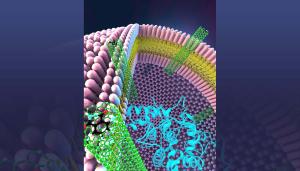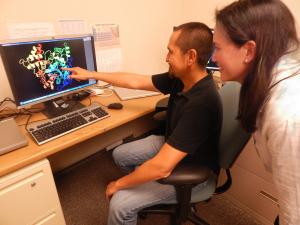LAB REPORT
Science and Technology Making Headlines
Oct. 31, 2014


An artist’s view of a carbon nanotube inserted in a plasma membrane of a cell. The nanotube forms a nanoscale tunnel in the membrane and the image shows a single long strand of DNA passing through that tunnel.
Help comes in small packages
A team led by Lawrence Livermore scientists has created a new kind of ion channel consisting of short carbon nanotubes, which can be inserted into synthetic bilayers and live cell membranes to form tiny pores that transport water, protons, small ions and DNA.
These carbon nanotube “porins” have significant implications for future health care and bioengineering applications. Nanotube porins eventually could be used to deliver drugs to the body, serve as a foundation of novel biosensors and DNA sequencing applications, and be used as components of synthetic cells.
Unlike taking a pill, which is absorbed slowly and is delivered to the entire body, carbon nanotubes can pinpoint an exact area to treat without harming surrounding organs.
“Many good and efficient drugs that treat diseases of one organ are quite toxic to another,” said Aleksandr Noy, an LLNL biophysicist who led the study. “This is why delivery to a particular part of the body and only releasing it there is much better.”


Amanda Randles
Insight into disease progression
Lawrence Livermore computational scientist Amanda Randles has received a Director's Early Independence Award from the National Institutes of Health (NIH).
The NIH Common Fund award provides funding to encourage exceptional young scientists to pursue "high risk, high reward" independent research in biomedical and behavioral science. The $2.5 million over five years grant will allow Randles to pursue research to develop a way of predicting likely sites for cancer to metastasize; a method that combines personalized massively parallel computational models and experimental approaches.
The goal of the project is to develop a method to simulate flow of realistic levels of cells through the circulatory system, thereby gaining insight into mechanisms that underlie disease progression and localization. "Building a detailed, realistic model of human blood flow is a formidable mathematical and computational challenge requiring large-scale fluid models as well as explicit models of suspended bodies like red blood cells," Randles said.


The onset of the collapse of the Antarctic Ice Sheet is one area a new project headed by Lawrence Livermore will examine.
The computing of climate
The Department of Energy has awarded a three-year, $54 million grant to a 14-member consortium of national laboratories, universities and other entities to develop climate models for high-performance computers that don’t yet exist.
The project is designed to accelerate the development of Earth system models that will improve projections of three specific components of climate change: water-cycle changes, biogeochemical feedbacks and the collapse of Antarctic ice sheets.
The consortium, called Accelerated Climate Modeling for Energy (ACME), will develop climate software to be run on next-generation supercomputers that are scheduled to be installed at Oak Ridge and Argonne national laboratories in 2017. Contracts for development of the machines are due to be awarded within the next few months. Since their computing architectures haven’t been determined, the ACME group will need to develop flexible and adaptable code, says David Bader, the principal investigator and a Lawrence Livermore National Laboratory atmospheric scientist.


The Antarctic Ocean is a remote place where icebergs frequently drift off the Antarctic coast and can be seen during their various stages of melting.
A stunning warm up
Southern Hemisphere oceans are warming at double the expected rate, according to a Lawrence Livermore study. This may explain why surface warming has slowed over the last decade -- the oceans have absorbed the "missing" heat.
Southern Hemisphere ocean temperatures have been rising much more quickly than previously thought, so much that global ocean warming may have been underestimated by as much as 24 percent to 55 percent.
The study sought to determine just how much we've underestimated long-term upper-ocean warming given the scarcity of data collected on Southern Hemisphere ocean temperature increases. "It's likely that due to the poor observational coverage, we just haven't been able to say definitively what the long-term rate of Southern Hemisphere ocean warming has been," said LLNL’s lead author Paul Durack.

LLNL researchers Monte LaBute (left) and Felice Lightstone (right) were part of a Lab team that recently published research detailing the use of supercomputers to link proteins to drug side effects.
Better medicine through supercomputing
Pharmaceutical companies create medications that help millions of people relieve pain from their medical conditions.
Despite extensive, expensive clinical trials for drug approval, more than 100,000 patients die each year from adverse drug reactions or side effects.
Researchers at Lawrence Livermore National Laboratory have discovered a high-tech method using supercomputers to identify proteins that cause medications to have certain side effects.





